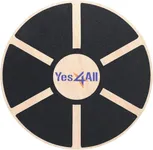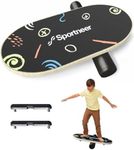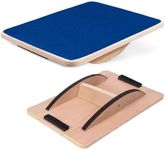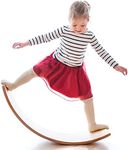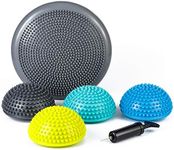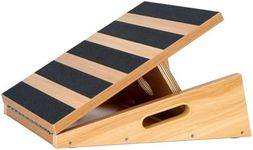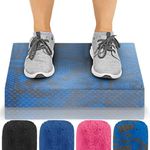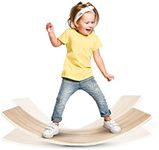Buying Guide for the Best Balance Boards For Kids
Balance boards for kids are a great way to help children develop their balance, coordination, and core strength. When choosing a balance board, it's important to consider several key specifications to ensure you select the best fit for your child's needs and abilities. Here are some important factors to consider when picking a balance board for kids.SizeThe size of the balance board is crucial because it needs to be appropriate for your child's age, height, and weight. Smaller boards are generally better for younger children as they are easier to control and maneuver. Larger boards may be more suitable for older kids or those with more advanced balance skills. To pick the right size, consider your child's age and physical development. A board that is too large or too small can be difficult to use and may not provide the intended benefits.
Weight CapacityWeight capacity refers to the maximum weight the balance board can safely support. This is important to ensure the board is safe and durable for your child. Balance boards typically have weight capacities ranging from 100 to 200 pounds. For younger children, a lower weight capacity may be sufficient, while older or heavier children will need a board with a higher weight capacity. Always check the manufacturer's recommendations and choose a board that can comfortably support your child's weight.
MaterialBalance boards can be made from various materials, including wood, plastic, and composite materials. Wooden boards are often more durable and provide a natural feel, but they can be heavier. Plastic boards are lighter and may be more affordable, but they might not be as sturdy. Composite materials offer a balance between durability and weight. Consider where and how the board will be used, as well as your child's preferences, when choosing the material.
Surface TextureThe surface texture of the balance board affects grip and safety. Some boards have a smooth surface, while others have a textured or non-slip surface to prevent slipping. A textured surface can provide better traction, especially if the board will be used on smooth floors or if your child tends to wear socks while using it. For added safety, look for a board with a non-slip surface to reduce the risk of falls and injuries.
Type of Balance BoardThere are different types of balance boards, including rocker boards, wobble boards, and roller boards. Rocker boards have a curved base and provide a back-and-forth motion, making them suitable for beginners. Wobble boards have a rounded base and offer 360-degree movement, which can be more challenging and beneficial for advanced balance training. Roller boards have a separate roller underneath the board, providing a dynamic and challenging experience. Choose the type of balance board based on your child's skill level and the type of balance training you want to achieve.
AdjustabilitySome balance boards offer adjustable features, such as interchangeable bases or adjustable height settings. This can be beneficial as it allows the board to grow with your child and adapt to their developing skills. Adjustable boards can provide a range of difficulty levels, making them suitable for both beginners and more advanced users. If you want a versatile board that can be used for a longer period, consider one with adjustable features.
![Balance Board Kids, [Natural Wood]](https://images-proxy.bestreviews.guide/BraE5nEnKxEkRxWjNd9fmruxeRM=/0x150/https://m.media-amazon.com/images/I/417d74ncx8L._AC_CX679_.jpg)
